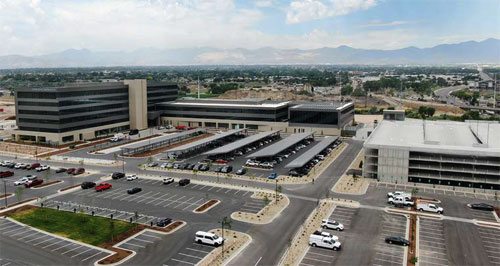Brice Wallace
The technological heart of Zions Bancorporation has a new home, and bank officials believe it will continue to pump out innovation that has been a bank hallmark.
The company recently had a ribbon-cutting ceremony for its Zions Bancorporation Technology Center, a new six-story, 400,000-square-foot tech campus in Midvale that will be the worksite for about 1,500 tech, operations and other employees.{mprestriction ids="1,3"} It consolidates work that previously had taken place in 11 smaller buildings and will serve Zions’ affiliate banks in 11 western U.S. states, in addition to several national lines of business.
During the ceremony, Harris Simmons, Zions’ chairman and CEO, recounted several of the bank’s technology innovations over the years, including those related to digital signatures and mobile check deposits.
“I’d like to think that we’ve shown that a bank like Zions Bancorporation can be quite capable of creating world-changing solutions and innovations right here that will happen in this building,” Simmons said. “And it’s my hope that this campus will be a place where that kind of creativity can take place.”
The center is at the former Sharon Steel Mill Environmental Protection Agency Superfund site, and a video shown during the ceremony described how “steel and coal” were transformed to “solar and wildlife.” The campus has incorporated several environmentally friendly elements, including using triple-pane exterior glass, ultra-efficient heating and cooling systems, more than 2,000 photovoltaic panels to produce up to 75 percent of the building’s electricity, 181 electric vehicle charging stations, and a regional habitat system through ecologically focused design and landscaping.
The center will house engineers, cybersecurity experts, developers, digital product leaders, workers who process deposits and loans, and call center teams. The campus will offer them workspaces that maximize natural light and views, a large café featuring a healthy menu, bike lockers, an adjacent community park with pickleball courts, sharable e-bikes, a community garden, and proximity to the Historic Gardner Village light rail station.
It also contains artwork by local artists Jann Haworth, Brian Kershisnik and Matt Monsoon.
“It’s a reminder to all of us, it certainly is to me, of the importance of creativity,” Simmons said. “Our best work always involves not only the left side, the analytical side, of our brains, but also the right side, the creative and artistic side of our minds, and when you bring those together, great things happen. … What we hope to have happen here is not only the day-to-day work that goes on, but also creating solutions to problems, and a certain amount of artistry is involved in that.”
Astrid S. Tuminez, president of Utah Valley University, said the building “is a gigantic pillar for community development” and part of today’s industrial revolution.
“The magnitude of change is huge. The magnitude of opportunity is also huge,” she said. “And so I feel very much that this building captures not only an understanding of the magnitude of change but the ability to seize the opportunity. …”
Scott Anderson, president and CEO of Zions Bank, noted that Zions began 149 years ago, before Utah was even a state. “But I do know that this new Zions Technology Center embodies how our company has grown and expanded its role as a financial institution and as a technology company, not only in Utah but in communities throughout the western United States,” he said.
Zions now is “a technology company offering financial services” and helps clients and communities, Anderson said.
“Exciting things will continue to happen here in this building,” he said, “as we build on the momentum and deliver new solutions to help strengthen our clients.”
The recent ceremony also featured three donations: $100,000 to the Silicon Slopes Computer Science Fund to help strengthen K-12 computer science education in Utah, $50,000 to the Jordan River Foundation, and $10,000 to the Canyons School District to support its Midvale Schools Farmers Market program.
The technology center was designed by architectural firms WRNS Studios and Method Studios and was built by Okland Construction and Layton Construction, with the project managed by Gardner Co. Colliers International assisted Zions Bancorporation with the property transaction.{/mprestriction}








